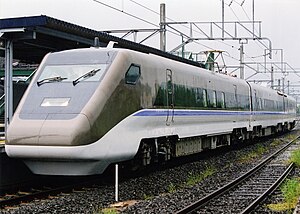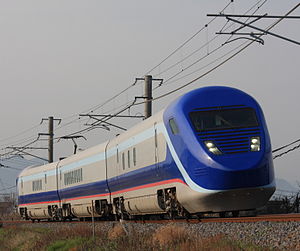Kikan Kahen Densha
The gauge change train ( Japanese 軌間可変電車 , dt. "Train with changeable track width"), even Gauge Change Train or Free Gauge Train ( フリーゲージトレイン, Furi Geji Torein ), is a test train for the Japanese high-speed network with umspurbaren undercarriages .
history
The conventional Japanese railway network has a cape gauge width of 1067 mm due to the topography of Japan with many mountains and narrow, winding gorges . The Shinkansen high-speed network, however, was built in standard gauge . For this reason, the "Mini-Shinkansen", Yamagata-Shinkansen and Akita-Shinkansen , which were built on the existing conventional railway lines, had to be converted to 1,435 mm. In order to avoid this expense for the infrastructure expansion in the future, the Gauge Change Train project was started in 1994. Around 32 billion yen (approx. € 300 million) has been invested in the Gauge Change Train project since 1994 (as of 2012)
The concept of Kikan Kahen Densha is comparable to the Spanish Talgo , e.g. B. the RENFE series 120 . So far, three test trains have been built. The first train was in use from 1998 to 2006, the second from 2006 to 2013. Starting in 2014, the third test train attempted to bring the technology to series production. This undertaking failed, however, in particular due to the findings on the significantly increased operating costs, so that currently (as of June 2020) no commercial use and thus the construction of series vehicles is planned. For this reason, other concepts have now been developed for the routes on which the Kikan Kahen Densha was originally intended to be used, e.g. B. a shuttle service on the Kyūshū Shinkansen or the construction of the southern section of the Hokuriku Shinkansen as a full-fledged Shinkansen.
1. Trial train (1998-2006)
| Kikan Kahen Densha Trial Train 1 (GCT01-01 to -03) |
|
|---|---|
|
The first test train on a test drive on the Yosan Line (May 2003)
|
|
| Number: | 1 (3 cars) |
| Manufacturer: | GCT01-1: Kawasaki HI GCT01-2: Kinki Sharyō GCT01-3: Tokyu Car Corporation |
| Year of construction (s): | 1998 |
| Retirement: | 2006 |
| Gauge : | variable |
| Top speed: | 300 km / h (Shinkansen) / 130 km / h (conventional routes) |
| Power system : | 25 kV / 50 Hz (Shinkansen) / 20 kV / 50 Hz (conventional routes) |
| Power transmission: | Overhead line 2 pantographs |
| Train control : | DS-ATC |
The construction of the first test train was completed in October 1998. It consisted of two power cars and an intermediate car and was designed for a maximum speed of 300 km / h on Shinkansen routes and 130 km / h on conventional routes. The development of the test train was carried out by the Railway Technical Research Institute (RTRI), the construction was carried out by a consortium of Kawasaki Heavy Industries , Kinki Sharyō and Tokyu Car Corporation .
Following the presentation in Tokyo in January 1999, the train was initially tested on the San'in main line at a maximum of 100 km / h. In April 1999, the train was shipped to the United States, where it was stationed for high-speed testing at the Transportation Technology Center in Pueblo, Colorado until January 2001. He achieved a maximum top speed in continuous operation of 246 km / h, covered approx. 600,000 km and completed approx. 2000 gauge changes.
From May 2003 the train was back in Japan, where it passed tests on the Yosan Line . This ended in 2006 when he was replaced by the second attempted train. All of the GCT01-01 to -03 cars from the first test train have been preserved and parked.
2nd test train (2006-2013)
| Kikan Kahen Densha Trial Train 2 (GCT01-201 to -203) |
|
|---|---|
|
The second test train during a test drive on the Yosan Line (March 2012)
|
|
| Number: | 1 (3 cars) |
| Year of construction (s): | 2006 |
| Retirement: | 2014 |
| Gauge : | variable |
| Length: | Power end: 23,075 mm Intermediate car: 20,500 mm |
| Top speed: | 270 km / h (Shinkansen) / 130 km / h (conventional routes) |
| Power system : | 25 kV / 50 Hz (Shinkansen) / 20 kV / 50 Hz (conventional routes) |
| Power transmission: | Overhead line 2 pantographs |
| Train control : | DS-ATC |
The second test train was originally supposed to be completed in 2004, but was not delivered until 2006. In May 2007 it was officially presented to the press. The second test train is based on the Shinkansen series E3 and, in addition to the two power cars GCT01-201 and -203, has a regular intermediate passenger car with 36 seats (GCT01-202).
After the second test train was initially tested on conventional routes, it was in test operation on the Kyūshū Shinkansen from June 2009 , where it was operated at a top speed of 270 km / h.
In 2011 the set was equipped with lighter bogies in order to achieve smoother running on curves with radii of less than 600 m. From August 2011, the train was traveling the Yosan Line at night at a maximum of 130 km / h in order to carry out endurance tests. By September 2013, the second test train had run a total of around 100,000 km.
The experience with the second test train flowed into the development of the successor model by JTRI, with which the technology is to be brought to series production.
3rd test train (since 2014)
| Kikan Kahen Densha Trial Train 3 (FGT-9001 to -9004) |
|
|---|---|
|
The 3rd test train at Matsubase station
|
|
| Number: | 1 (4 cars) |
| Manufacturer: | FGT-9001: Kawasaki HI FGT-9002: Hitachi FGT-9003: Kawasaki HI FGT-9004: Kawasaki HI |
| Year of construction (s): | 2014 |
| Gauge : | variable |
| Length: | 23,075 mm (end car) 20,500 mm (middle car) |
| Height: | 3,650 mm |
| Width: | 2,945 mm |
| Power system : | 25 kV / 50 Hz (Shinkansen) / 20 kV / 50 Hz (conventional routes) |
| Power transmission: | Overhead line 2 pantographs |
A third test train has been used on Kyūshū since October 2014 . The aim is to bring the automatic gauging technology to series production, in order to be able to start developing series vehicles for the Nagasaki route of the Kyūshū Shinkansen from 2017 . On the around 110 km long Nagasaki route, which is expected to go into operation in 2023, around 66 km between the Takeo Onsen and Nagasaki stations will be expanded as a standard-gauge full Shinkansen route. On the other hand, on the remaining 45 km between Takeo Oasen and Shin Tosu , where the connection to the Kagoshima route will be made, the existing Cape Gauge route will continue to be used.
For the test runs of the third test train, a gauge change system was built at Shin-Yatsushiro station on the Kagoshima route of the Kyūshū Shinkansen, so that it can switch from the Shinkansen to the Cape-lane Kagoshima main line . The four-car train was developed by JRTT and has a gold-colored base paint with a dark red stripe on the roof and side skirts and is operated by JR Kyūshū as the 9000 series. In February 2014, the train manufactured by Kawasaki HI and Hitachi was transferred to JR Kyūshū . All four cars are powered, so the train on the Kyūshū Shinkansen has the same propulsion and braking power as the Shinkansen 800 series . For the conventional routes, the performance profile of the third test train corresponds to that of the 885 series manufactured by Hitachi .
On April 19, 2014, the third test train was presented to the public. The official start of the test program was on October 19, 2014, during which the train is expected to complete around 600,000 kilometers within three years. After the discovery of cracks in the running wheels, the train had to be completely redesigned.
In June 2017, JR Kyūshū announced that it was no longer planning to use the Gauge Change Train on the Nagasaki route of the Kyūshū Shinkansen. The reasons cited were concerns about cost and safety.
Web links
Individual evidence
- ↑ 直通 運 転 化 の 手法. (PDF) Niigata Prefecture, August 9, 2009, accessed May 26, 2014 (Japanese).
- ↑ New GCT train hampered by speed, weight problems. (No longer available online.) Asahi Shinbum, May 2, 2012, archived from the original on May 6, 2012 ; accessed on May 26, 2014 (English). Info: The archive link was inserted automatically and has not yet been checked. Please check the original and archive link according to the instructions and then remove this notice.
- ↑ Kazuhiro Oda: GCT field tests. In: RTRI QR 2003 Vol. 44 No. 1. Asahi Shinbum, 2003, accessed May 26, 2014 .
- ↑ 下 関 で 車輪 幅 の 変 換 試 験 を 公開 フ リ ー ゲ ー ジ 電車. Kyodo News, April 29, 2009, accessed May 26, 2014 (Japanese).
- ↑ About Free Gauge Train Technology. (PDF) (No longer available online.) Ministry of Land, Infrastructure, Transport and Tourism, archived from the original on March 1, 2014 ; Retrieved April 26, 2014 . Info: The archive link was inserted automatically and has not yet been checked. Please check the original and archive link according to the instructions and then remove this notice.
- ↑ Government of Nagasaki Prefecture: Free Gauge Train ( Memento of the original from September 28, 2014 in the Internet Archive ) Info: The archive link was automatically inserted and has not yet been checked. Please check the original and archive link according to the instructions and then remove this notice. (Japanese)
- ↑ Photo of the flyover
- ↑ Makoto Tsuchiya: New train that can traverse different tracks starts trials in Kumamoto. (No longer available online.) Asahi Shinbum, April 20, 2014, archived from the original on April 26, 2014 ; accessed on April 26, 2014 (English). Info: The archive link was inserted automatically and has not yet been checked. Please check the original and archive link according to the instructions and then remove this notice.
- ↑ Gauge-changing Free Gauge Train on test in Kyushu. Kyodo News, October 21, 2014, accessed October 24, 2014 .
- ↑ 長崎 新 幹線 、 フ リ ー ゲ ー ジ 車 両 の 導入 断 念 JR 九州. Nikkei, June 13, 2017, accessed July 20, 2018 (Japanese).





